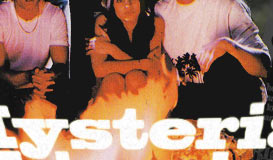

52) One of the books describes the bulb as "a consolidated nucleus of the personality, which can appear to the alchemist as symbols." There were other women like this, she thought. Finding it, Lilly felt her body lighten as if she had crossed through the barrier of her shame. "The bulb between a naked woman's legs was in one of the illustrations made by Maria the Jewess from Babylon in the second century. She knows the image of the bulb between her legs comes from an alchemy book, which she searches for during a secret overnight stay in the Sarah Lawrence Library. (An epigraph at the start of the book explains that "hystera" is from the Greek root "hysteria," meaning "the wandering uterus." Hippocrates viewed the womb as an independent creature that could wander throughout the body if a woman engaged in unnatural behavior.) She struggles to keep the bulb's existence secret from her doctor and the staff of the hospital, which only serves to increase her emotional disturbance. She is obsessed with a bulb that appears to be growing in her uterus. Lilly experiences a fever dream of guilt, visions, alchemy, and sexual confusion. When the break occurs, Lilly's roommate, Jane, takes her to the emergency room. Her father is intelligent but generally neglectful. Her mother alternately tyrannizes her with unpredictable rages and smothers her with desperate neediness. In flashbacks, the younger Lilly is fascinated by her mother's work and some books on alchemy, but their relationship is fraught. Helen is a master bookbinder who works in the basement of their suburban home repairing old books sent from Israel. Helen was raised in Old Jerusalem and educated in London, eventually immigrating to the United States, where she married Lilly's father, David Weill, an entertainment lawyer in New York City. We learn that Lilly is a student at Sarah Lawrence College trying to make her way toward emotional independence from her domineering and very complex mother, Helen, who, it soon becomes clear, has her own burdens. How she got there, literally and figuratively, is revealed through Skolkin-Smith's effective use of flashbacks.

Hystera follows Lilly's journey through madness, from her initial examination at the hospital to her stay in a New York City psychiatric hospital to her eventual discharge.

It is a short but powerful depiction of a young woman's emotional breakdown following the accidental death of her father, for which she blames herself. Leora Skolkin-Smith's Hystera is one of those books. It's no secret that the publishing world is so crowded with books that outstanding, even important, books sometimes get lost in that crowd.


 0 kommentar(er)
0 kommentar(er)
